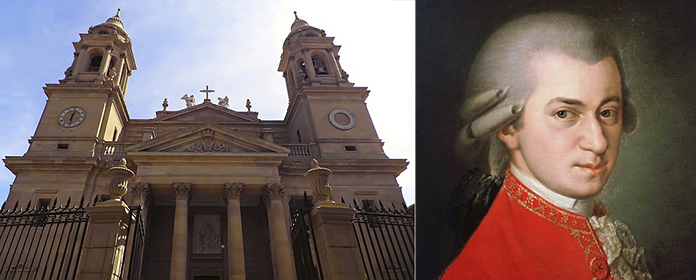The Institute for Culture and Society and the Music Chapel of the Cathedral of Pamplona present an unpublished score of Mozart's Requiem.
The recovery of the scores has been framed in the project 'Chantria Pampilonense' and they have been interpreted in the Mass for the Deceased in the Cathedral.

PHOTO: Courtesy
The high school Cultural and Society (ICS) of the University of Navarra has presented together with the Music Chapel of the Cathedral of Pamplona and with the partnership of the City Council of Pamplona some unpublished scores of Mozart's Requiem archived in the Cabildo. The presentation took place last November 2 during the Mass of the Dead, event for which it was composed according to Aurelio Sagaseta, director of the Music Chapel.
The recovery of the score, which consists of 15 papers, has been made thanks to the project 'Chantria Pampilonense', framed in the line of research of the ICS 'Creativity and Cultural Heritage'. This project arose from the agreement between the University of Navarra and the Cathedral for the restoration of the musical heritage of the Chapter. Rafael Zafra, researcher of the ICS; Miguel A. Marín, musicologist; and Sagaseta himself have been involved in the work .
After consulting international experts -such as Christoph Wolff(Harvard University) and Simon Keefe(Cambridge University)- and comparing the archives of other Spanish cathedrals, it has been verified that there are no similar scores in the country. In addition, it has been confirmed that the work was never played, given the perfect condition of the 15 parts and the lack of annotations.
"The hypothesis is that the Cabildo of Pamplona ordered a copy of the work a few years after Mozart's death", said director de Capilla. It arrived at the file of Music of the Cathedral where it was kept without ever being premiered.
A period settingThe organizers wanted the performance of the work to be as faithful as possible to its original conception. Thus, it was performed during the Mass for the Dead. The Introit-Requiem, the Kyrie, the Offertory or the Sanctus could be heard, although, after the liturgy, the central part of the score was offered: from Dies irae to Lacrymosa.
On the other hand, some instruments were changed to adapt it to the initial idea: horns for trumpets, bassoons for trombones, clarinets in C were used and the timpani were dispensed with. "The result is a more mournful work, more requiem and less brilliant than the usual versions," said Sagaseta. In addition, other liturgical elements from the end of the 18th century were used, such as antique velvet chasubles, a large baroque tower of the paschal candle or an 18th century triangular skylight with 15 'pro defunctis' candles.
The interpretation of the scores was performed by the Orquesta Sinfónica de Navarra, the Cathedral organist Julián Ayesa, the choir of the Capilla de Música and four internationally renowned soloists: Dorota Grzeskowiak (soprano), Liuboy Melnik (alto), José Luis Sola (tenor) and Silvano Baztán (baritone). The maestro de Capilla of the Cathedral conducted. The Mass, celebrated in Latin, was presided over by the Dean of the Cathedral, Carlos Ayerra, and José Antonio Pedroarena, a monk from Leyre, acted as deacon and sang the Gospel in Gregorian.
